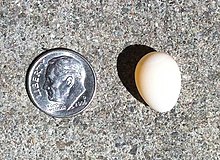
Back Mida AN سایز CKB Abmessungen German Tamaño (medida) Spanish Mõõtmed Estonian اندازه Persian Չափ Armenian Ũruuno (size) KI 크기 Korean Saiz Malay





Size in general is the magnitude or dimensions of a thing. More specifically, geometrical size (or spatial size) can refer to three geometrical measures: length, area, or volume. Length can be generalized to other linear dimensions (width, height, diameter, perimeter). Size can also be measured in terms of mass, especially when assuming a density range.
In mathematical terms, "size is a concept abstracted from the process of measuring by comparing a longer to a shorter".[1] Size is determined by the process of comparing or measuring objects, which results in the determination of the magnitude of a quantity, such as length or mass, relative to a unit of measurement. Such a magnitude is usually expressed as a numerical value of units on a previously established spatial scale, such as meters or inches.
The sizes with which humans tend to be most familiar are body dimensions (measures of anthropometry), which include measures such as human height and human body weight. These measures can, in the aggregate, allow the generation of commercially useful distributions of products that accommodate expected body sizes,[2] as with the creation of clothing sizes and shoe sizes, and with the standardization of door frame dimensions, ceiling heights, and bed sizes. The human experience of size can lead to a psychological tendency towards size bias,[3] wherein the relative importance or perceived complexity of organisms and other objects is judged based on their size relative to humans, and particularly whether this size makes them easy to observe without aid.
- ^ C. Smoryński, History of Mathematics: A Supplement (2008), p. 76.
- ^ Thomas T. Samaras, Human Body Size and the Laws of Scaling (2007), p. 3.
- ^ "The notion that bacteria are primitive, unsophisticated organisms stems from what I would call size chauvinism". Matthews, Clifford (1995). Cosmic beginnings and human ends : where science and religion meet. Chicago and LaSalle, Ill: Open Court. p. 208. ISBN 978-0-8126-9270-9. OCLC 31435749.